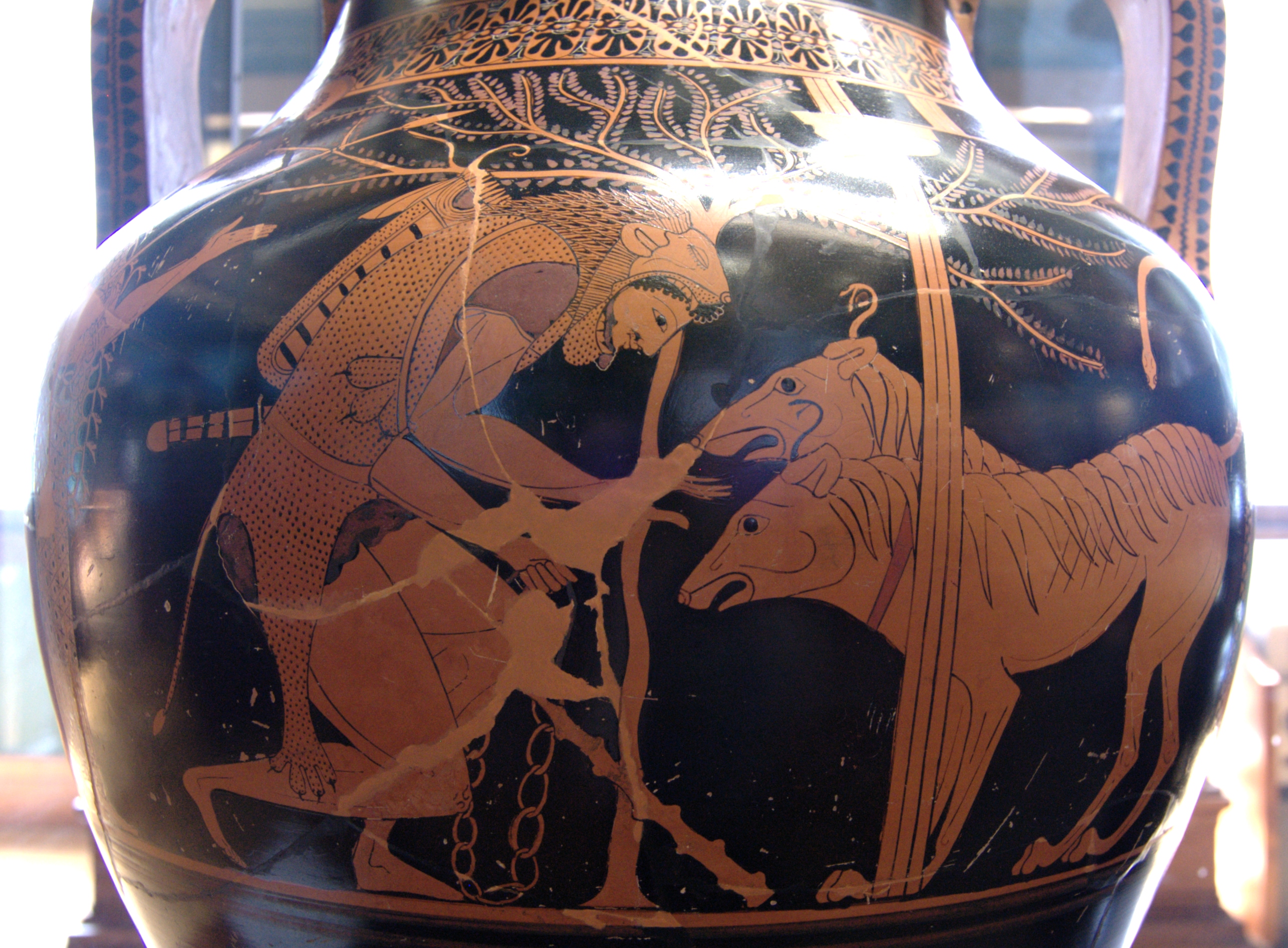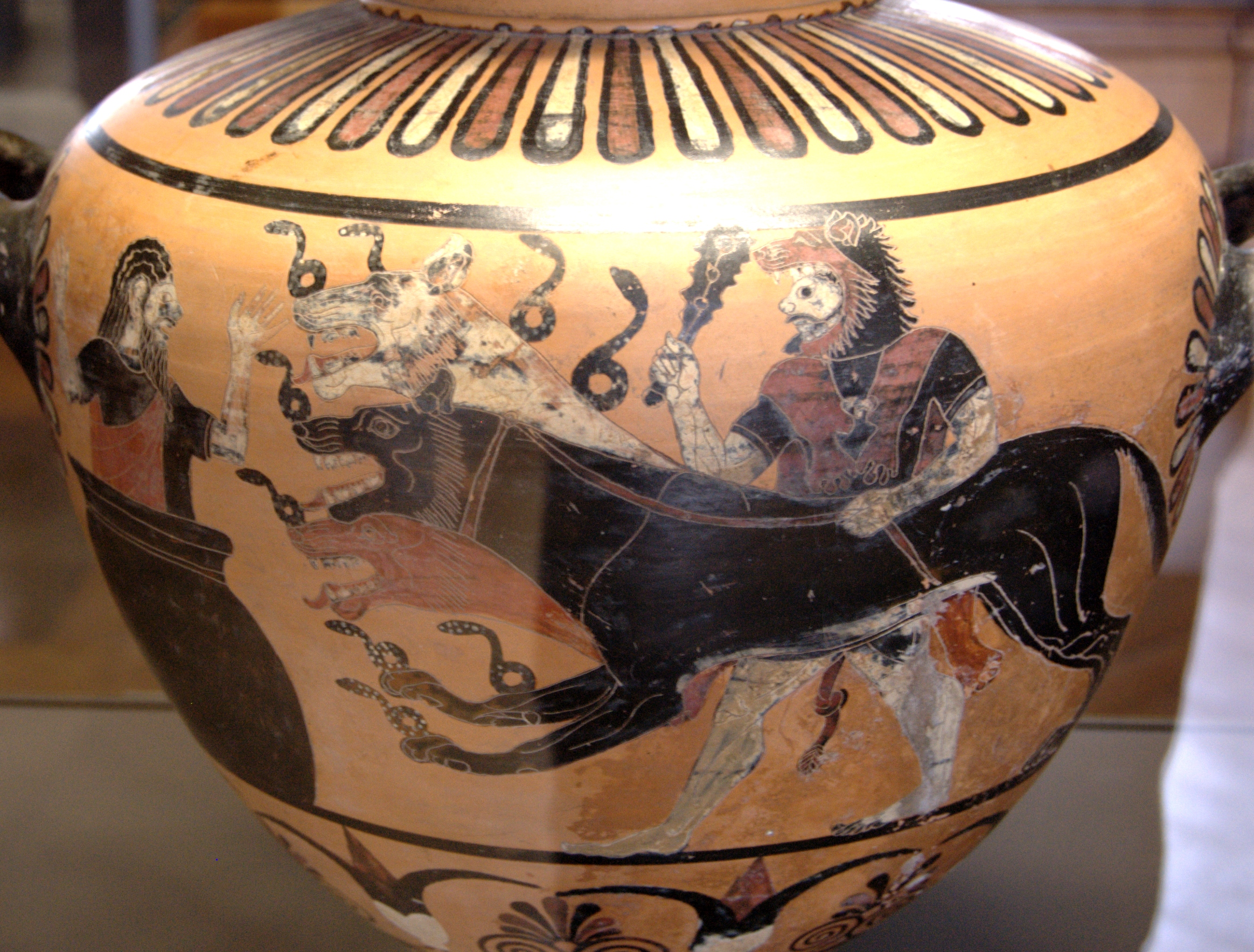November’s Roman Calendar Feature
The 2019–2020 Roman
Calendar features twelve mythical monsters from the 2019 edition of Martia Dementia, Bolchazy-Carducci’s annual
spring bracket tournament. Visit us on social media (Facebook, Twitter, and our blog) for
announcements regarding the 2020 Martia
Dementia.
.jpg) |
Cerberus, third-century BCE Sidonian Burial Caves
(© Creative Commons Attribution-Share Alike 2.0 Generic/Ian Scott)
|
The infernal hound Cerberus is famous for his three
heads, as in this third-century BCE tomb painting. The painting was found in
the Sidonian Burial Caves in central Israel. These burial caves belonged to a
family that originated in Sidon in what is now Lebanon.
Ancient sources differ in their depictions of
Cerberus. The Greek poet Hesiod (ca. 750–650 BCE)
describes Cerberus as having fifty heads (Theogony 306–12):
τῇ δὲ
Τυφάονά φασι μιγήμεναι ἐν φιλότητι
δεινόν θ᾽ ὑβριστήν τ᾽ ἄνομόν θ᾽ ἑλικώπιδι
κούρῃ:
ἣ δ᾽ ὑποκυσαμένη τέκετο κρατερόφρονα
τέκνα.
Ὄρθον μὲν πρῶτον κύνα γείνατο Γηρυονῆι:
310 δεύτερον αὖτις ἔτικτεν ἀμήχανον, οὔ τι
φατειὸν
Κέρβερον ὠμηστήν, Ἀίδεω κύνα
χαλκεόφωνον,
πεντηκοντακέφαλον, ἀναιδέα τε
κρατερόν τε:
Men say that Typhaon the
terrible, outrageous and lawless, was joined in love to her [Echidna], the maid
with glancing eyes. So she conceived and brought forth fierce offspring; first
she bore Orthus the hound of Geryones, [310] and then again she bore a second,
a monster not to be overcome and that may not be described, Cerberus who eats
raw flesh, the brazen-voiced hound of Hades, fifty-headed, relentless and
strong.
translation
in Hesiod, the Homeric Hymns, and
Homerica by Hugh G. Evelyn-White
In Horace’s telling (Odes 2.13.33–36), the songs of the poets
Alcaeus and Sappho transfix a hundred-headed Cerberus and other denizens of the
Underworld:
quid
mirum, ubi illis carminibus stupens
demittit
atras belua centiceps
35 auris
et intorti capillis
Eumenidum
recreantur angues?
What
marvel, when at those sweet airs
The
hundred-headed beast spell-bound
Each
black ear droops, and Furies' hairs
Uncoil
their serpents at the sound?
translation
in Horace: The Odes and Carmen Saeculare
of Horace by John Conington
Orpheus was also famous for enchanting Cerberus
and other intimidating figures on his journey to the Underworld, as in Vergil’s
rendition (Georgics 4.481–484):
Quin
ipsae stupuere domus atque intima Leti
tartara
caeruleosque implexae crinibus angues
Eumenides,
tenuitque inhians tria Cerberus ora
atque
Ixionii vento rota constitit orbis.
Nay,
even the deep Tartarean Halls of death
Stood
lost in wonderment, and the Eumenides [Furies],
Their
brows with livid locks of serpents twined;
Even
Cerberus held his triple jaws agape,
And,
the wind hushed, Ixion's wheel stood still.
translation
in Bucolics, Aeneid, and Georgics Of
Vergil by J. B. Greenough
 |
Hercules and Cerberus on a sixth-century BCE
red-figure
amphora now housed at the Louvre (Public Domain)
|
Prodigiumque
triplex, armenti dives Hiberi
Geryones, quamvis in tribus unus erat;
Inque
canes totidem trunco digestus ab uno
Cerberos inplicitis angue minante comis;
You
tell also of the heads that were fixed upon Thracian gates, and the mares
fattened by the blood of men; of Geryon, that three-fold monster, rich in
Iberian herds, who had three bodies in one; of Cerberus, forming three dogs
from the same trunk, having his hair wreathed with hissing snakes . . .
translation
in The Epistles of Ovid, translated into
English prose . . .
 |
Hercules presenting Cerberus to Eurystheus on a
sixth-century BCE
black-figure hydria, also at the Louvre (Public Domain)
|
Teachers may wish to ask students to discuss other
depictions of Cerberus that they have encountered, and which written
descriptions match them most closely.
—Laurel Draper, Editor
—Laurel Draper, Editor

No comments:
Post a Comment